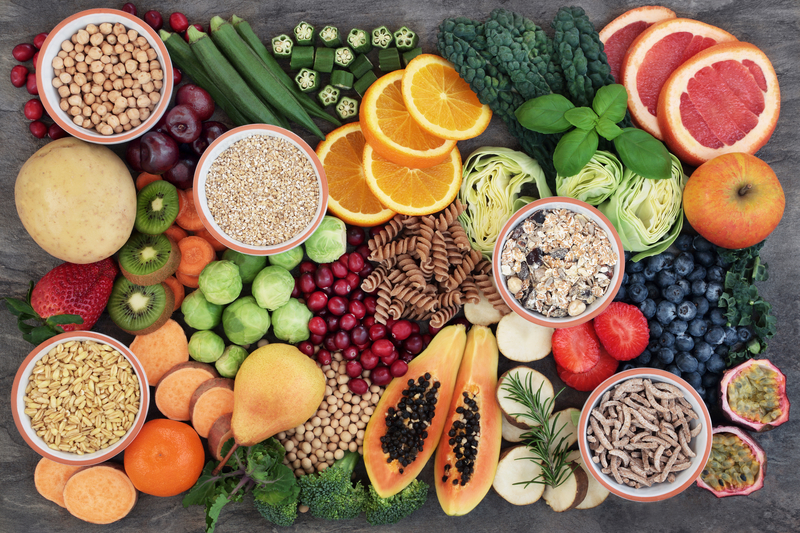7 Easy Ways to Eat More Fiber (without even trying)

If you’re like most people, you aren’t eating nearly enough fiber. While the recommended intake for fiber is 25 to 30 grams a day (and even as high as 40 grams a day), the average American consumes a paltry 12 to 15 grams per day. And now that many people are cutting down on—if not cutting out—carbs, the problem appears to just be getting worse. So, how can you eat more fiber?
Fiber is perhaps best known for helping keep the digestive system “regular.” And while that’s certainly true, there’s a whole lot more to dietary fiber. It can help prevent weight gain, promote weight loss, improve glycemic control, promote heart health, and even protect against certain forms of even cancer. So, the advice to eat more fiber, which is found naturally in plant-based foods like vegetables, fruits, legumes, nuts, seeds, and whole grains, is as relevant today as ever before.
So, if you’re not getting enough fiber now, how can you possibly increase your intake (more than double your intake in most cases!) without a colossal effort? After all, you know the benefits of fiber, you know you should eat more fiber, but it’s just not that easy to consume more—especially if you’re convinced that you need to be watching your carb intake. Right?
Alas, that’s what brings you here today: to find ways to sneak more fiber into the diet, so you can enjoy all of the benefits fiber provides, without feeling like you have to turn your life upside down or chug down thick, sludgy concoctions made with psyllium husk. (Eww!)
7 Sneaky Ways to Eat More Fiber
- Eat more veggies and fruits. Okay, this isn’t really “sneaky”—it’s really obvious, in fact. Please forgive me, but it is perhaps the easiest way to eat more fiber without chowing down on a whole bunch of extra calories.
When you’re hungry for a snack, grab some fresh-cut veggies and hummus (carrots pack 3.6 grams in 1 cup; sugar snap peas provide 4 grams in a cup), or slice up an apple (4.4 grams) or pear (6 grams) and enjoy it with some peanut butter. Believe it or not, bananas, which often get a bad rap, contain over 3 grams (per medium banana). Reach for a handful of blackberries for 7.6 grams per cup or raspberries for 8 grams per cup. Add a big handful of dark leafy greens to your morning smoothie (1.4 grams in two cups). Or top your omelet with ¼ of sliced avocado for 3.4 delicious grams with breakfast.
To increase the odds of eating your veggies (and fiber), when you bring them home from the store, wash them, cut them up, and have them ready to eat. That way, they’re super convenient to grab and eat rather than hidden away in the deep recesses of the crisper drawer (out of sight, out of mind).
Then, before you eat your main meal, eat some veggies. In one study, women who ate a salad before eating their meal ate 23% more vegetables. This practice has also been linked to eating fewer calories during a meal. Or, enjoy some cut-up vegetables as you prepare the rest of your meals.
- Add beans and legumes. Packed with fiber, beans can often absorb the flavors of the foods they’re combined with, so they’re super versatile. They can be added to everything from salads to soups to muffins to meatloaf to spreads and even to smoothies! Yes, you read that right. They can even be added to smoothies, which they make smoother and creamier!
Canned beans are quick and affordable, and as a bonus, they also provide extra protein in addition to a healthy serving of fiber. A half cup of kidney beans, for example, will fill you up with 5.7 grams of fiber, chickpeas provide 8.1 gram in a half cup, and lentils (which can be bought dry as they’re faster and easier to cook than most beans) will give you 7.8 grams in a half cup.
Looking for a pasta alternative that isn’t a zoodle? You can enjoy black bean spaghetti, which provides 180 calories, 12 grams of fiber, and 25 grams of protein; chickpea shells that will fill you up with 190 calories, 8 grams of fiber, and 14 grams of protein; or red lentil pasta, which will give you 26 grams of fiber and 14 grams of protein with 206 calories.
- Snack on popcorn. Many people think of movie popcorn, bathed in oil and butter, as being unhealthy. They’re right. Naked, air-popped popcorn, on the other hand, can be a fun, healthy snack filled with fiber. One cup of air-popped popcorn delivers 1.2 grams of fiber yet only 31 calories. When you get up to a more realistic serving size (let’s say 4 cups), you’ll get 5 grams of fiber yet still only 124 calories.
Surprisingly, popcorn also provides polyphenols, which are antioxidants linked to a reduced risk of heart disease and cancer. Here’s to guilt-free movie munching!
- Give up refined grains for whole grains. Refined grains—such as white flour and the “foods” made with it—are available in abundance, yet whole grains are so much richer in flavor, nutrients, and fiber due to their vitamin-rich germ and fiber-filled bran. Even if you’re going gluten-free, you can enjoy whole gains such as oatmeal, brown rice, quinoa, and some of the more exotic grains like amaranth and teff.
For example, you’ll get 4 to 5 grams of fiber per ¼ cup (dry) serving of oatmeal (depending on whether you want rolled oats or steel-cut). If you are not watching gluten, bulgur wheat can provide 4.1 grams per half cup, for example.
- Gather some nuts. Looking to eat more fiber? Do not forget about nuts!
Packed with protein, fiber, and fat, nuts are a healthy addition to virtually any diet. They’re easy to grab and go and are super for snacking.
For a nice boost of fiber, try pistachios, for instance, which provide 2.8 grams per ounce, or almonds at 4.5 grams in just a ¼ cup.
- Sample the seeds. Like nuts, seeds can be a terrific source of fiber along with omega-3 fatty acids, protein, vitamins, and minerals. Chia seeds, for example, provide a whopping 11 grams of fiber per ounce! Flax, sesame, and hemp seeds have similarly impressive profiles and are smart additions to a fibrous nutrition plan.
Seeds like chia provide a type of fiber known as “insoluble.” This form is known for helping keep the digestive track running well, which is key to colon health and has also been linked to a lower risk for diabetes.
- Enjoy your chocolate. While candy bars and hot cocoa typically pack loads of added sugar and should be enjoyed very much in moderation, ithere’s no reason to completely give up this treat if you’re a fan of chocolate. For example, just add two tablespoons of unsweetened cocoa powder to your morning protein shake or smoothie for 4 grams of indulgent fiber.
Eating more fiber really doesn’t need to be difficult. Now that you’re aware of why you should eat more fiber (better overall health and weight management, for example), and you know the foods that pack the most fiber, start making a game out of how much fiber you can eat in a day.
One caveat, though: START SLOWLY. Too much fiber too soon can make you gassy and bloated, so build up by adding more fibrous foods over time. And before long, you’ll be laughing at how easy it can be to eat the recommended amount of fiber without resorting to some thick, gloppy fiber drink. Keep in mind that even though eating more fiber is a good thing for MOST people, some people may respond poorly. In other words, as with most things, individual differences apply.







